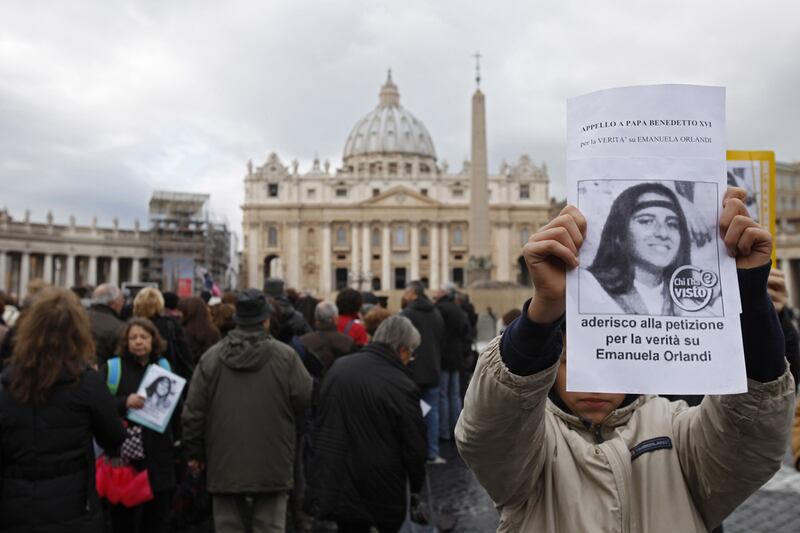The faint smell of incense and candle wax permeates the church of Sant’Apollinare near Rome’s famous Piazza Navona. The basilica is one of a handful of churches outside the walls of Vatican City owned by the Holy See. It is used primarily by members of the ultra-conservative Opus Dei prelature for special masses for student priests and for celebrations of marriage and baptism of those affiliated with the sect. Behind a side door near the back of the basilica is a small courtyard that’s closed to the public. There, in an external crypt near the ornate sarcophaguses of bishops and cardinals, is the curious tomb of Enrico “Renatino” De Pedis, a prominent member of the infamous Magliana organized-crime gang who was ambushed and murdered by rival gang members in 1990.
Why a known-mobster like De Pedis is buried on the grounds of a Vatican church has been the object of much speculation since 1997, when a church maid revealed the tomb’s existence to an inquisitive journalist. The Vatican was always cagey about why the mobster was buried in one of its churches, and ultimately, the church’s silence spurred countless conspiracy theories. Now, thanks to shocking Vatican letters leaked in the Vatileaks scandal that is rocking the Holy See, the Italian police are less interested in why he’s buried there. Instead, they want to open the tomb to see if the remains of 15-year-old Emanuela Orlandi are interred with those of the mobster.
Orlandi was the daughter of a prominent non-clerical Vatican employee who worked in the Vatican’s special events office that organizes papal functions and Catholic celebrations. She disappeared without a trace after leaving her Vatican apartment for music lessons on the afternoon of June 22, 1983. Her lessons were in a music school adjacent to Sant’Apollinare church, and the last witnesses to see her alive told investigators the girl crawled into a dark green BMW, though that lead could never be corroborated. Her disappearance came at a tense moment for the Vatican, and nearly everyone associated her presumed kidnapping with a wider scandal. In 1981, Mehmet Ali Agca, a Turkish gunman, shot Pope John Paul II, nearly killing him. Orlandi’s parents received a series of phone calls from thugs who said they would give back their daughter if the Vatican released Ali Agca. The calls soon stopped and the Orlandi family was left wondering if their daughter was alive or dead.
Another theory surfaced a year later, when an unidentifed tipster told police Orlandi was kidnapped to keep her father quiet. Mr. Orlandi, it was said, had stumbled upon sensitive documents that tied Roberto Calvi, known as God’s Banker for his close association with both the Holy See and its primary banking facility, Banco Ambrosiano, and to an organized-crime syndicate. Calvi had been found hanged under Blackfriars Bridge in London in 1982, and speculation was swiftly turning from suicide to homicide in that case. It made sense that if the elder Orlandi knew something, taking his daughter would surely seal his lips.

At the time of the teenager’s disappearance, the Vatican secret service firmly believed she was kidnapped to be used as leverage either by supporters of Ali Agca or Calvi. Last Saturday, the Vatican’s chief spokesman, Federico Lombardi, acknowledged they probably were wrong. “At the time, the authorities shared the prevailing opinion that the kidnapping might have been used by some obscure criminal organization to send messages or enact pressure in the context of the jailing and interrogation of the pope’s attacker,” he said.
But because the Vatican is a sovereign city-state, Italian police do not have jurisdiction to investigate so-called Vatican crimes. The investigation began in earnest again after a series of breaks in late 2004, but John Paul II died shortly after the new lead surfaced, and the thread was lost in the transition in leadership at the Holy See. In 2008, the case was opened again when the transcript of an Italian police interrogation with De Pedis’s lover tied the mobster to the girl’s disappearance. The lover told police the young girl was kidnapped on the orders of Archbishop Paul Marcinkus, who was then the head of the Vatican bank.
Marcinkus, an American, died in 2006, but records show that even the Vatican was suspicious of the priest. De Pedis’s lover said the death was to avenge a debt after the Vatican reneged on mafia loans secured by De Pedis, and that the girl’s body was dumped in a cement truck near the Roman seaside town of Ostia. De Pedis, having exacted his revenge, then forgave the loan in exchange for the prestigious burial plot inside the Vatican church, she said.
Now, the focus of the investigation has turned to the Vatican itself, and, according to revelations in a letter leaked to the Italian press last week, the Vatican is taking it very seriously. A three-page letter from Lombardi to church higher-ups indicated even he suspected a cover-up. In the letter, shown on Italian Rai Tre state television, Lombardi wrote of his concerns and asked how to address the press. “Was the non-collaboration [in the initial Orlandi investigation] normal and justifiable affirmation of Vatican sovereignty, or if in fact circumstances were withheld that might have helped clear something up.”
Italian magistrates are now wondering the same thing, and say they feel the Vatican may still be covering up vital information about Orlandi’s mysterious disappearance. They are picking up on a series of leads that stalled in 2005, starting with a tip from an anonymous caller to an Italian detective program Chi’l’ha Visto (“Who Has Seen”). The caller said Orlandi was kidnapped on the orders of the then vicar of Rome, Cardinal Ugo Poletti, and that “the secret to the mystery lies in a tomb in Sant’ Apollinare basilica.”
Last month, former Rome mayor and vice premier Walter Veltroni took up the case, asking the Italian interior ministry to ascertain whether the church of Sant’Apollinare is protected from Italian law or whether investigators could exhume De Pedis’s tomb. The Vatican quickly offered access to the tomb and suggested that perhaps moving the mobster’s remains was a way to quash speculation once and for all. But in an about-face this week, the prosecutors backed down and said they won’t be opening the tomb anytime soon—saying instead that it’s time for someone inside the Vatican to tell the truth. “There are those in the Curia who know elements of the circumstantial evidence,” Giancarlo Capaldo, assistant prosecutor in the case, said on Italian television. “There are people still alive, and still inside the Vatican, who know the truth.”
In the meantime Orlandi’s family is hoping investigators change their minds and open the tomb, even though De Pedis’s widow, Carla Di Giovanni, reportedly is the only person with keys, and now even she is under preliminary investigation in the nearly three-decade-old mystery and probably not feeling very cooperative.
“The declaration by the prosecutors that the truth is known in the Vatican is very heavy, but it’s overshadowed by the strange decision not to open De Pedis’s grave,” Orlandi’s brother, Peter, told La Stampa newspaper over the weekend. “Implicating the Holy See directly is a huge step forward. Now the Holy See has a moral duty to give a response after years of refusing to cooperate.”
But as long as it’s sealed, the mobster’s grave won’t give up any ghosts, or shed any light on the mystery.






